It’s been a busy few months. In August I spent nearly two weeks in Tanzania leading a safari workshop (the Serengeti, returning in 2023). September I was up in South Dakota running a workshop there. Early October it was Maine for another workshop (Acadia), then after a few days home (and covering a Chiefs game), hit the road once more, this time to the west coast for two workshops in Oregon. Finally, after another Chiefs game, I returned to Utah the second week of November for my last workshop of the year (Moab). Whew! All those trips generated a number of great ideas for blog posts in the coming months, but first a little catch up. I’ll start with Acadia: what we did, where we went, and most importantly, the photos we made.
Cadillac Mountain is the high point in Acadia, and while I find there are better photos to be made elsewhere, a trip to Acadia wouldn’t be complete without a visit to its summit. This year, because of crowding, the park service instituted new rules, so now you have to get a permit (online, ahead of time) to drive the road to the top. We did that for the first evening, and while the sky was mostly overcast, still found a few photos worth making.
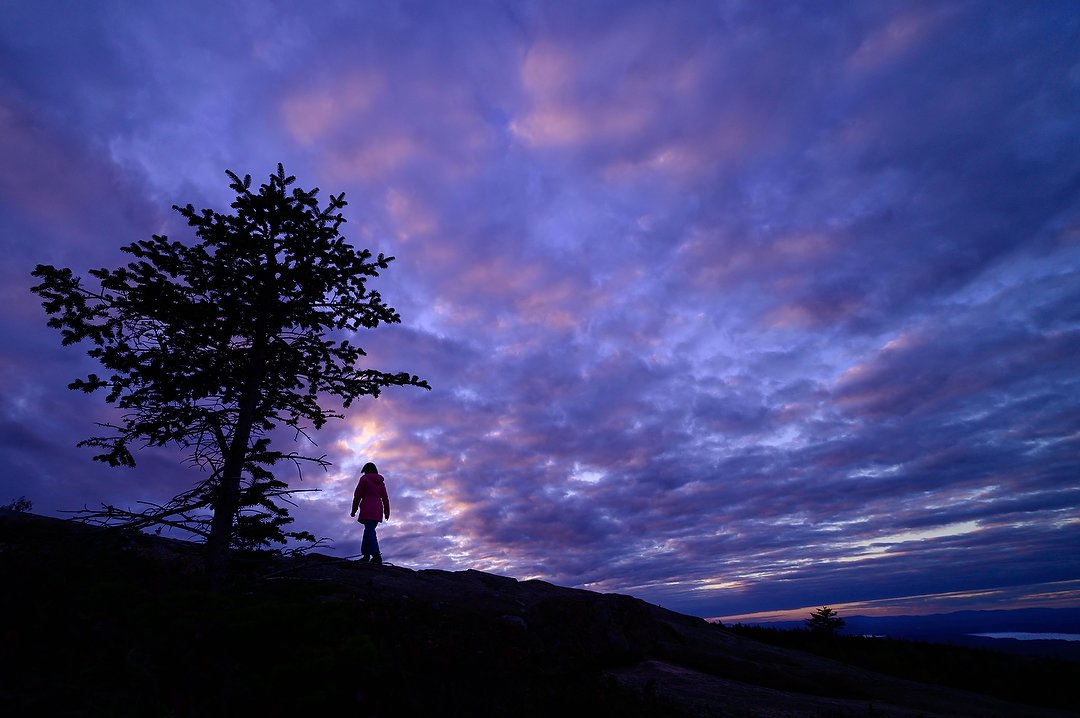
We didn’t get much of a sunset on that first evening visit to Cadillac Mountain, but there was a bit of light in the sky to work with. In that case, I always look for a good subject to put against the sky. Waiting for someone to walk through made it even better, and changing my white balance played to the slight purple cast of the light. Nikon Z 6, Aperture Priority, Mercury lamp white balance, ISO 250, 1/125 at f/8 in Matrix metering, -1.3 EV, Nikkor = Z 14-30mm f/4 S lens at 14mm. =
One of my future blog posts will be about paying attention to the little things, and that’s what I urged the group to do on our first morning’s visit to Thuya Gardens. While driving there I had some questions about focus stacking, so spent the first thirty-minutes at the gardens giving an impromptu class on Focus Shift shooting.
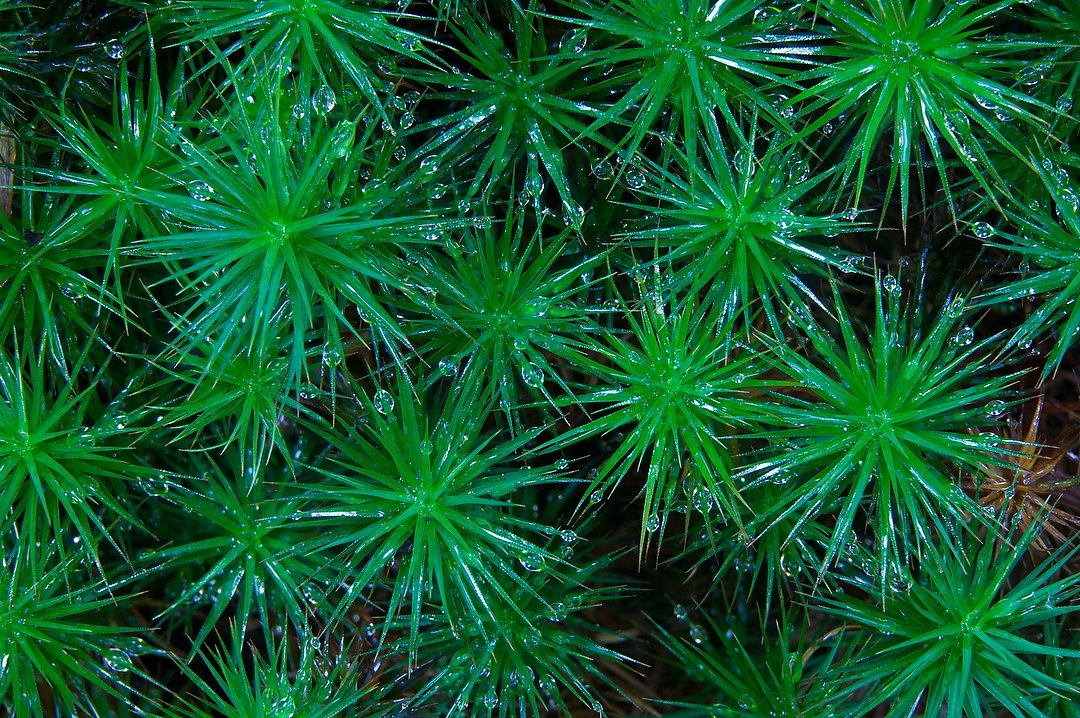
I used the Focus Shift feature on my Nikon camera, with an extension tube and 24-200mm lens to shoot this at Thuya Gardens. Then I assembled the eleven frames taken into one final image in Helicon Focus. NIKON Z 6 II, Aperture Priority, Natural auto white balance, ISO 400, 2.5 at f/16 in Matrix metering, -0.7 EV, Nikkor Z 24-200mm f/4-6.3 VR lens at 125mm.
After that we headed to one of the little fishing towns that dot the southern coast of Mount Desert Island. A few of us met a lobsterman on a pier, preparing his traps (“pots”). We began asking questions and ended up hearing a lengthy explanation of what his life is like, including an average day and the ups and downs of pricing. Fascinating as that was, none of us came away with a desire to join the business.
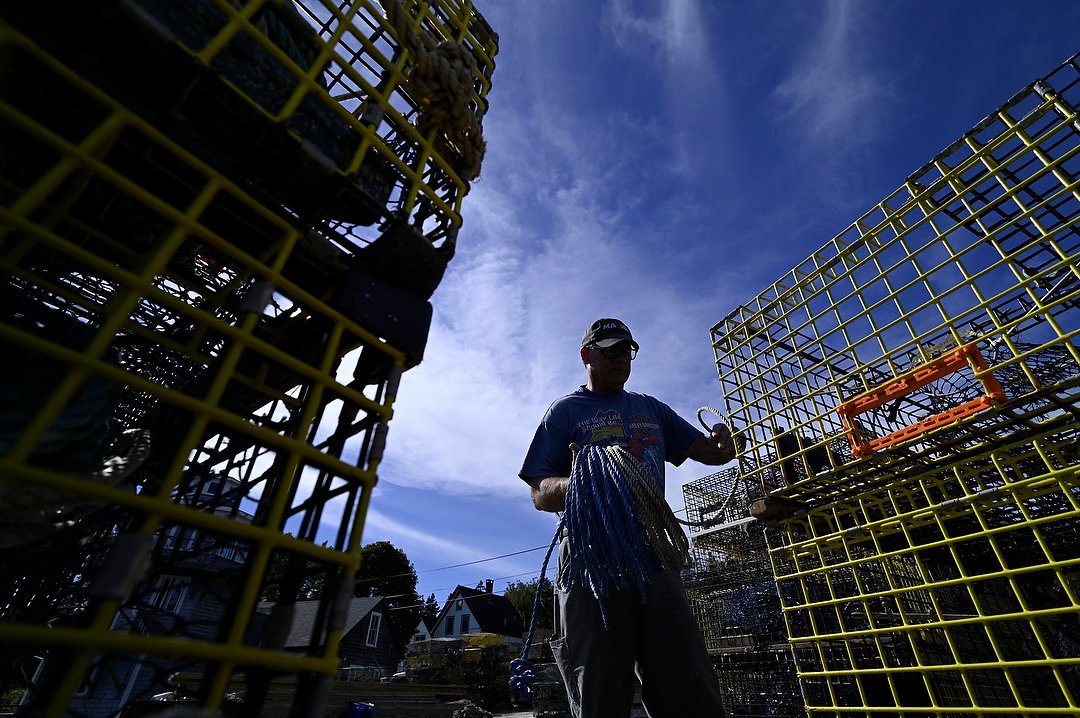
With a strong sky behind him, I chose to photograph this lobsterman from a low angle, framing him between the traps as he coiled rope. Nikon Z 6, Aperture Priority, Natural auto white balance, ISO 160, 1/1000 at f/8 in Matrix metering, -0.3 EV, Nikkor Z 14-30mm f/4 S lens at 16mm.
Bass Harbor Head Lighthouse is listed as a “must-see” spot on the island, so we arrived there in late afternoon to photograph sunset. We were not alone. With a small parking lot, and in the midst of prime “leaf-peeper” season, the line of cars for those few spaces snaked out well over a mile. My assistant and I dropped our groups off so they could go in and find spots to shoot from while we waited in line. Eventually we both were able to park and made it down to the viewing area well before sunset. However, that evening there was no beautiful sunset. I’m an optimist by nature, so always hopeful the light will work for us. Unfortunately, it doesn’t always happen that way. But that’s the life of a photographer.
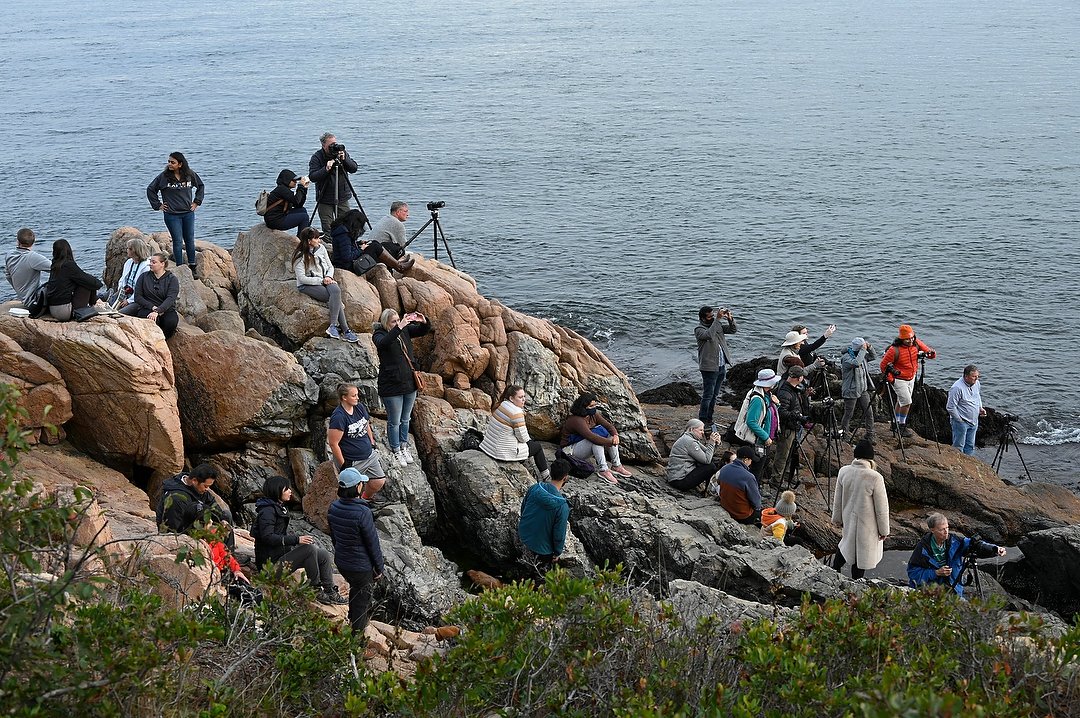
As you can see, it gets quite crowded on the rocks that have the best view of Bass Harbor Head Lighthouse at sunset. Nikon Z 6 II, Aperture Priority, Natural auto white balance, ISO 400, 1/50 at f/6.3 in Matrix metering, -0.3 EV, Nikkor Z 24-200mm f/4-6.3 VR lens at 46mm.
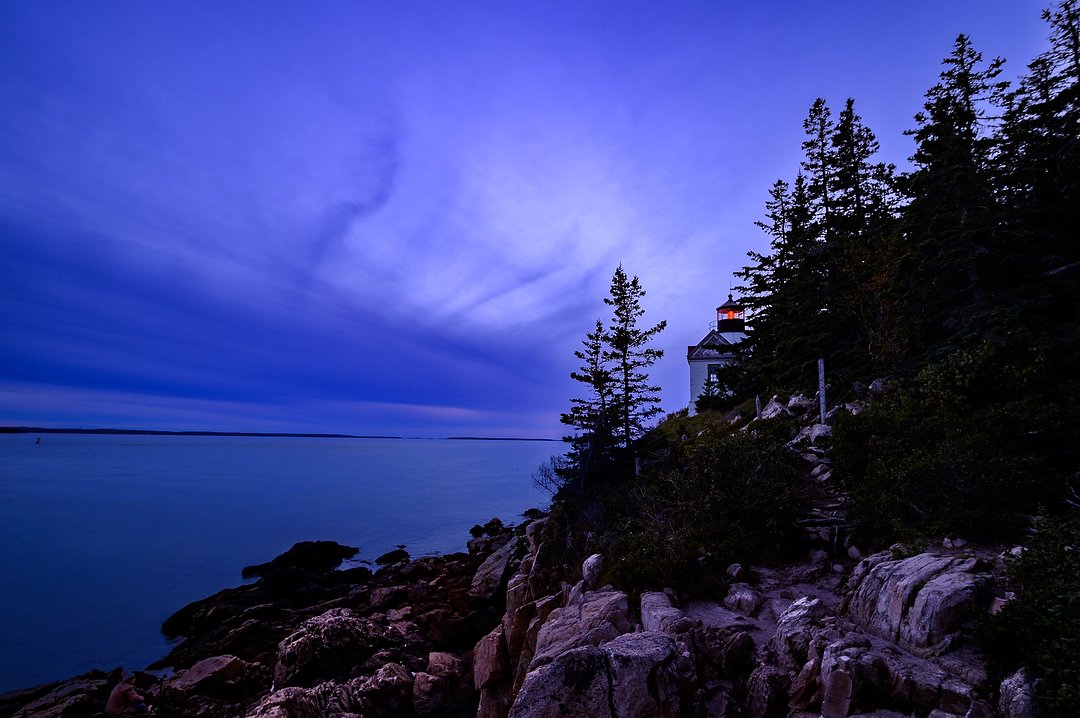
Not the sunset we were hoping for. That’s why I always remind people that to be a photographer, you have to learn to live with disappointment. Things don’t always go the way you’d like them to. It’s a good life lesson as well. Nikon Z 6, Aperture Priority, Mercury lamp white balance, ISO 160, 1/15 at f/7.1 in Matrix metering, -0.3 EV, Nikkor Z 14-30mm f/4 S lens at 18mm.
The next morning we started early with a pre-dawn visit to “Boulder Beach.” It’s not marked as such, but well known because it’s almost entirely covered by (mostly) round rocks. It’s a challenge to walk across during daylight, but in the dark – even with headlamps – treacherous. I suggested the group settle near the top, so less chance of broken ankles, and use flashlights or speedlights to light the foreground rocks until the sun rose.
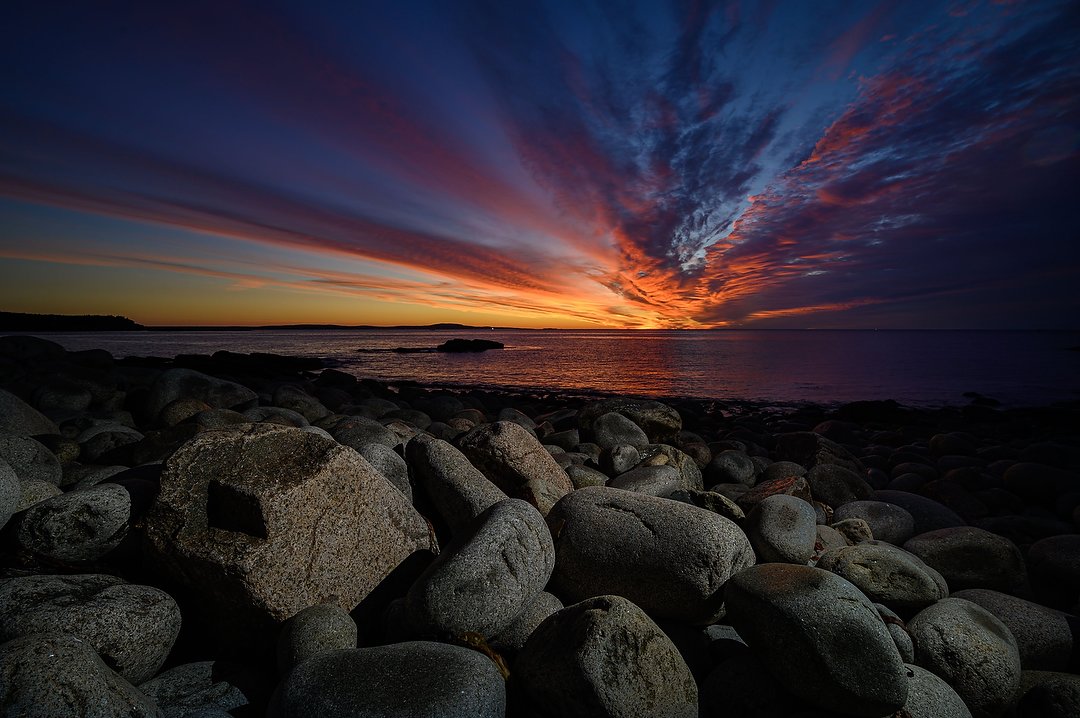
Despite the beautiful sky, until the sun breaks the horizon there’s no light to work with in the foreground. So I used my Nikon SB-5000 speedlight to add some illumination from the right side to show the rocks. Nikon Z 6, Manual exposure, Sunny white balance, ISO 100, 1/10 at f/11, Nikkor Z 14-30mm f/4 S lens at 15.mm.
That afternoon we enjoyed a nice, long wander at Sieur de Monts. Not mountain or seashore, it’s a nice mix of woods and meadows, with a lake thrown in for good measure. A great place to visit whether sunny or cloudy, it offers loads of good close-up photos.
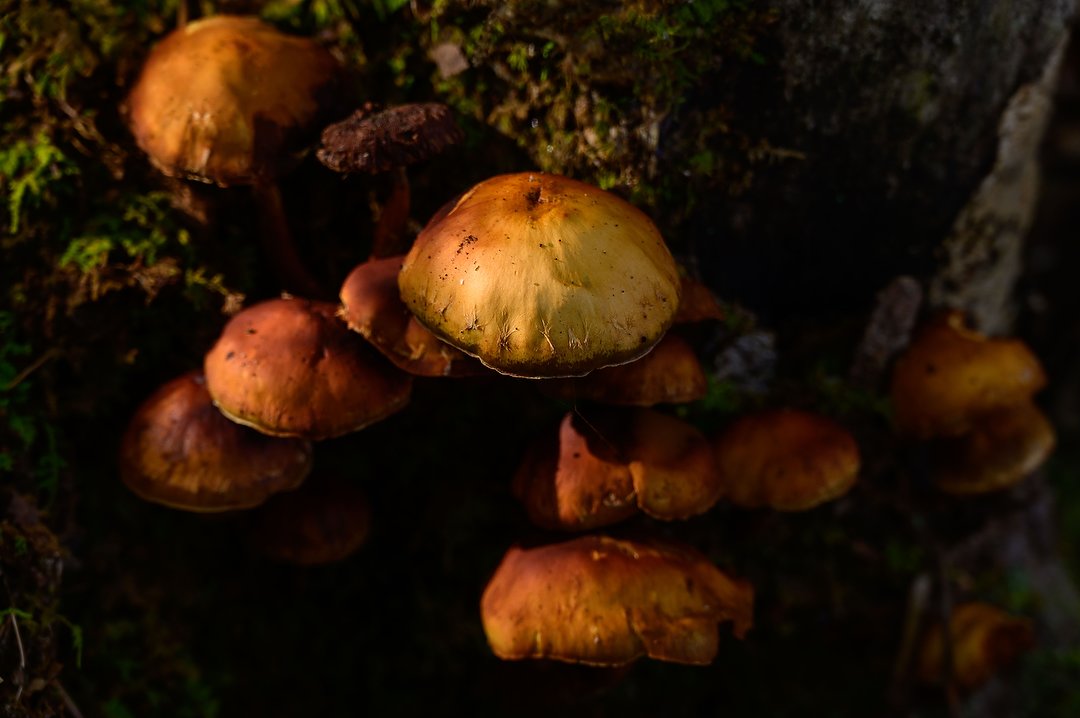
I love all the great close-up opportunities you can find at Sieur de Monts. The bit of sidelight on these colorful mushrooms is what caught my eye as I walked past. Nikon Z 6 II, Aperture Priority, Natural auto white balance, ISO 400, 1/40 at f/8 in multi-segment metering, -1.3 EV, Nikkor Z 24-200mm f/4-6.3 VR lens at 140mm.
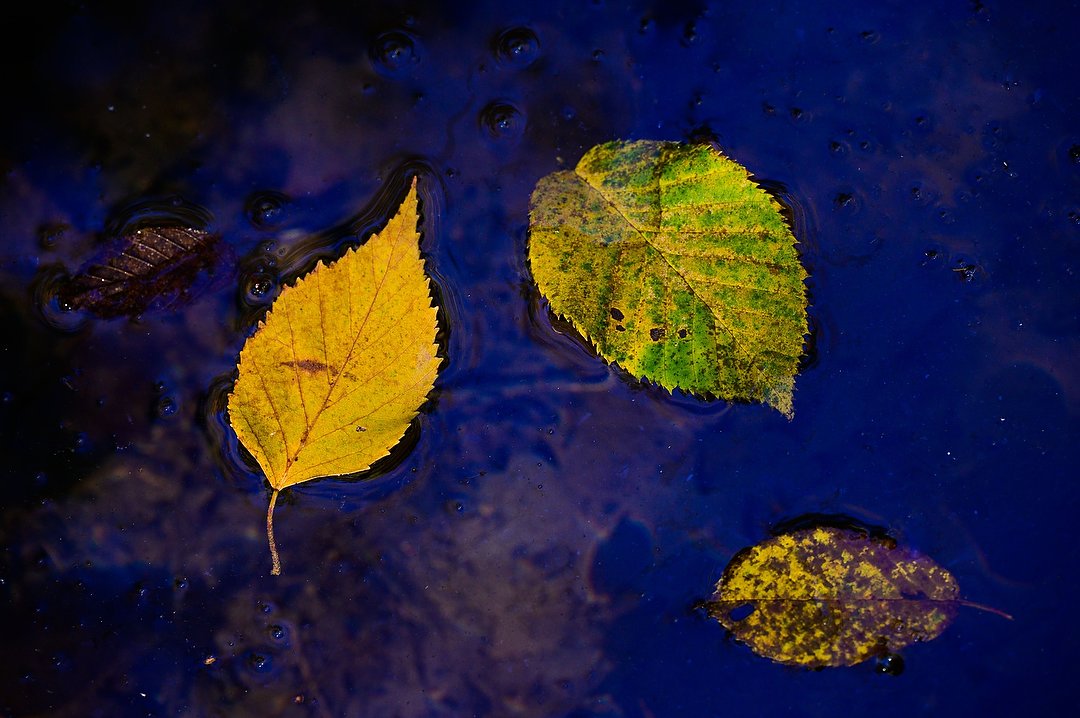
Another nice detail from Sieur de Monts, this time of a few leaves in water reflecting the blue sky. Nikon Z 6 II, Aperture Priority, Natural auto white balance, ISO 500, 1/200 at f/8 in Matrix metering, -1.7 EV, Nikkor Z 24-200mm f/4-6.3 VR lens at 200mm.
Our sunset location that day was Jordan Pond. Since I’d been there many times before, I showed the group where some of the best photo locations were near the south end, then went off to explore a bit further on my own. Up the trail and around the corner I found a beautiful little cove, with a few trees showing their full fall color. We stayed past sunset to continue with a night shoot, as I used Lume Cubes to light a section of the rocky shoreline for the group (I didn’t shoot that, just worked the lights and helped folks with their focus and exposure).
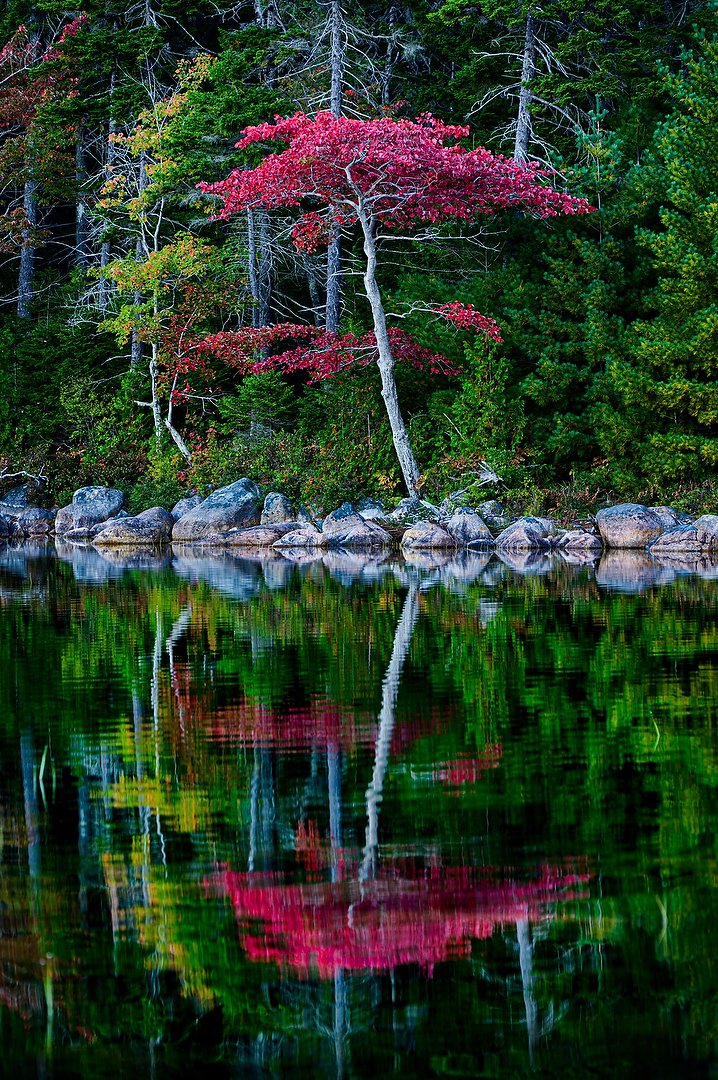
Despite the dim light, having my tripod meant I could stay at a low ISO to show off this brightly colored tree in a side cove at Jordan Pond. Nikon Z 6 II, Aperture Priority, Sunny white balance, ISO 100, 1/4 at f/8 in Matrix metering, -0.3 EV, Nikkor Z 24-200mm f/4-6.3 VR lens at 170mm.
The third day I let everyone sleep in, then we did a walking tour of the town of Bar Harbor. Its reputation as a beautiful small town is well-deserved. We returned to nature in the afternoon, making the drive over to the much less visited Schoodic Peninsula. The big attraction there is the point, which has slabs of rock that jut out into the Atlantic Ocean. Staying there through sunset, I then led another light shoot, once again using Lume Cubes to light some foreground subjects. We were gifted with a bonus view of the Milky Way as well.
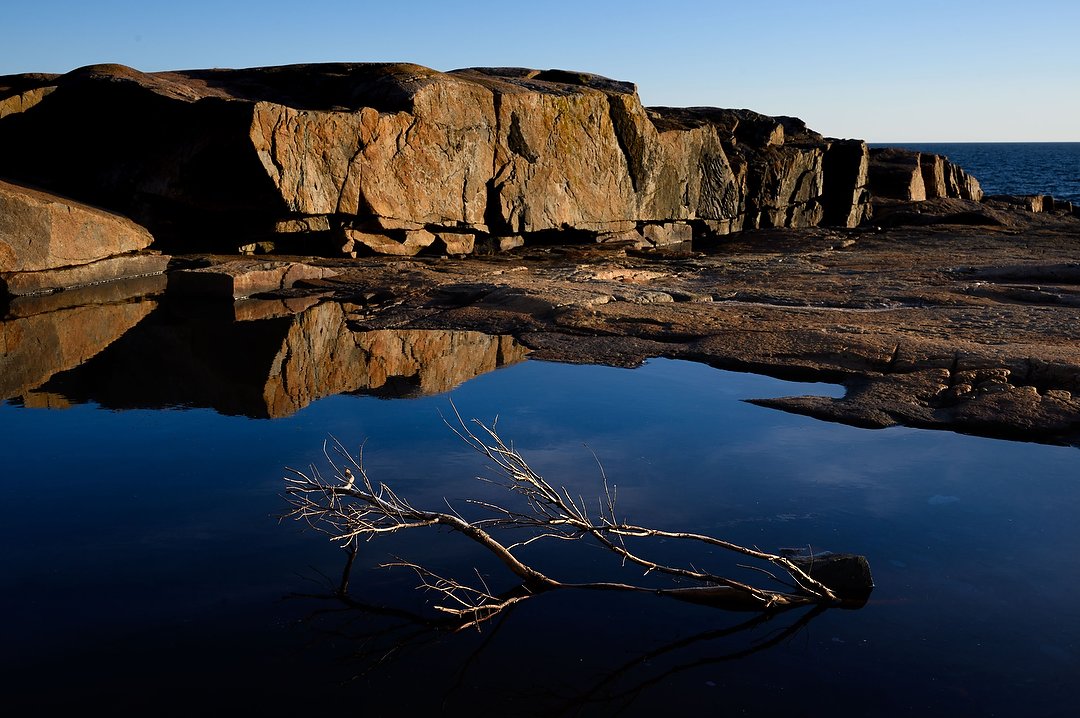
Being about an hour-and-a-half drive from Bar Harbor, Schoodic Peninsula doesn’t get many visitors. That’s fine with me, as it gives us more freedom to explore and photograph this beautiful area. Nikon Z 6 II, Aperture Priority, Natural auto white balance, ISO 100, 1/100 at f/11 in Matrix metering, -1.3 EV, Nikkor Z 24-200mm f/4-6.3 VR lens at 35mm.
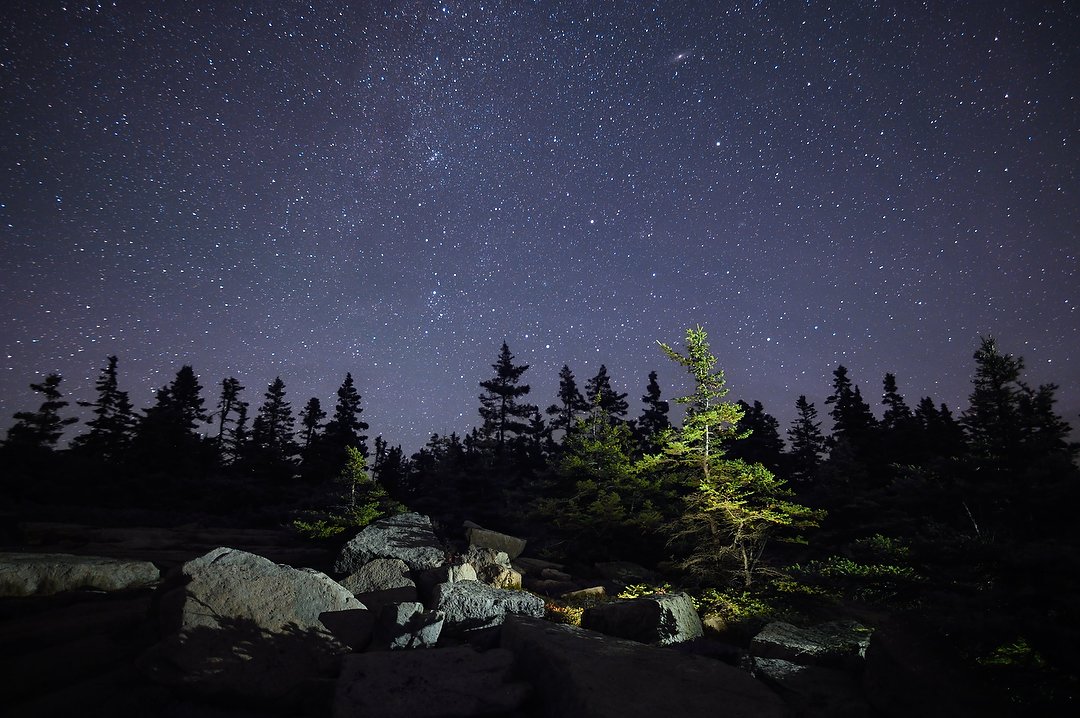
This is the night shoot we did on Schoodic Peninsula, as I used two Lume Cubes to light the tree and rocks. Nikon Z 6, Manual exposure, Preset 3 white balance, ISO 2000, 20-seconds at f/2.2, Nikkor AF 20mm f/1.8G lens.
Our final day began before dawn once more, this time working our way along Ocean Path Trail and the rock ledges that border that eastern edge of the island. Again, we used flashlights or flash to light foreground subjects until the sun broke the horizon. Finished there, we visited Sand Beach to shoot wave action before returning to Bar Harbor for lunch. That afternoon we headed inland again, to the town of Somes and the old cemetery there. Sunset found us in one of the western bays, where we learned about the mussel industry by a trucker waiting for a fresh load of the shellfish to come off the water.
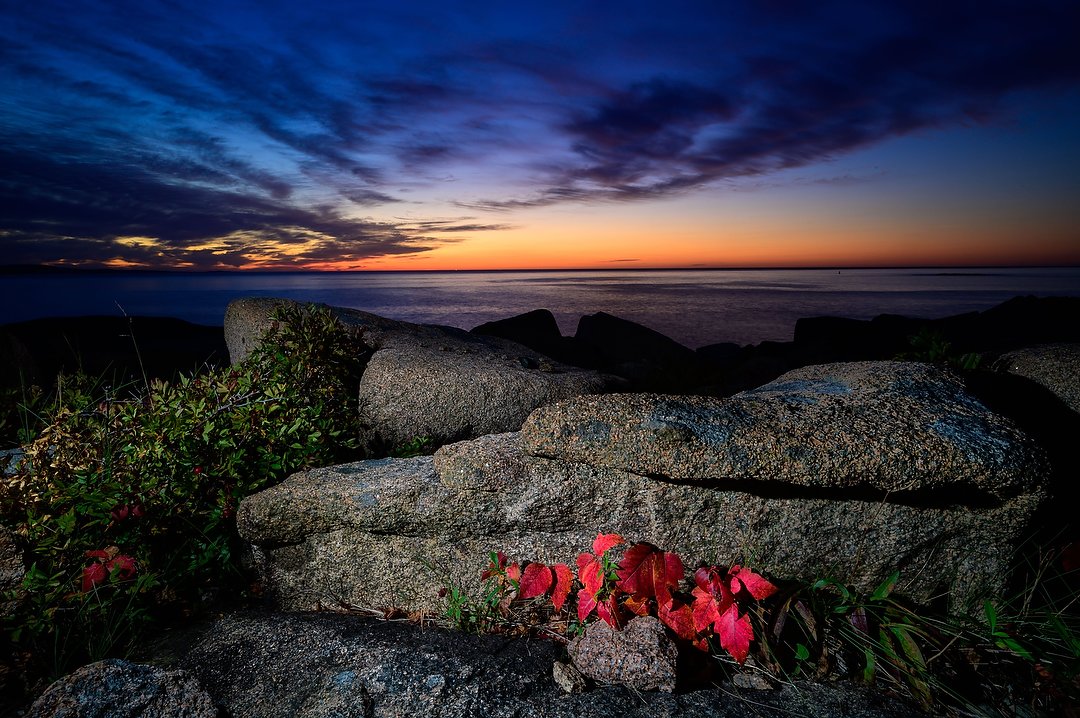
I love photographing these ledges of rock along Ocean Path Trail. With another nice sunrise, we once more needed to use some light source to bring out the foreground. This time I used that same Nikon SB-5000 speedlight, but in Manual power, firing it three separate times to light different areas of the scene from the left and above. I plan to write a story about this technique in the next few months. Nikon Z 6, Manual exposure, Sunny white balance, ISO 100, 4-seconds at f/22, Nikkor Z 14-30mm f/4 S lens at 19mm.
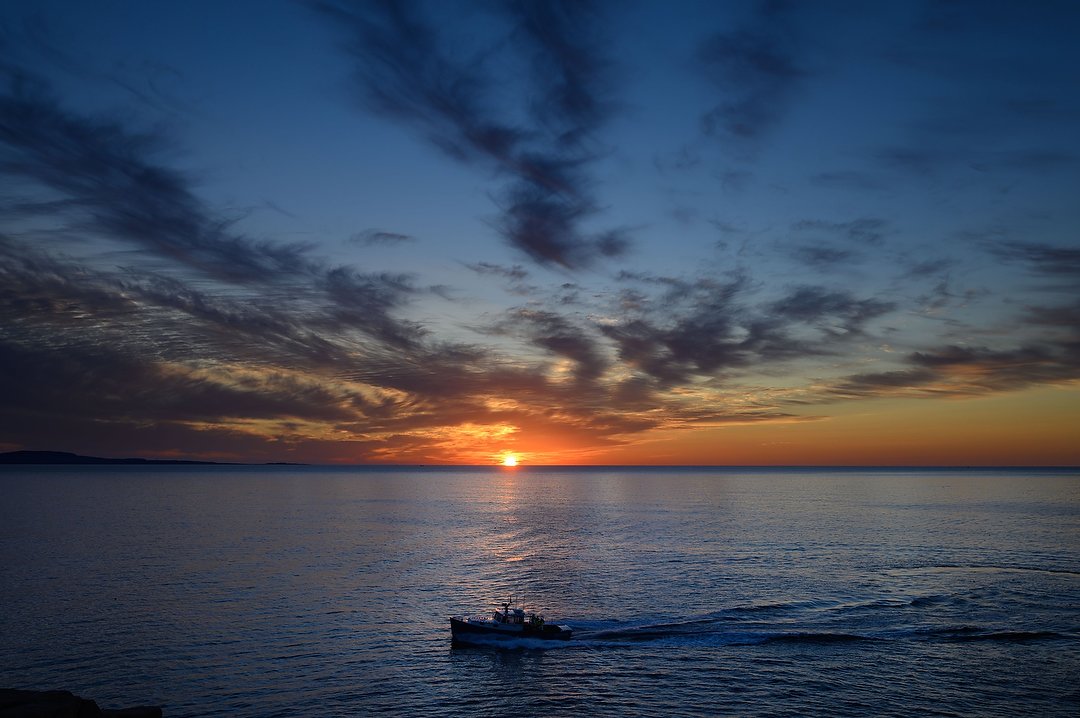
After the sun crested the horizon, we watched a lobsterman checking his pots along the shore. Nikon Z 6, Aperture Priority, Sunny white balance, ISO 100, 1/125 at f/8 in Matrix metering, -1.0 EV, Nikkor Z 14-30mm f/4 S lens at 30mm.
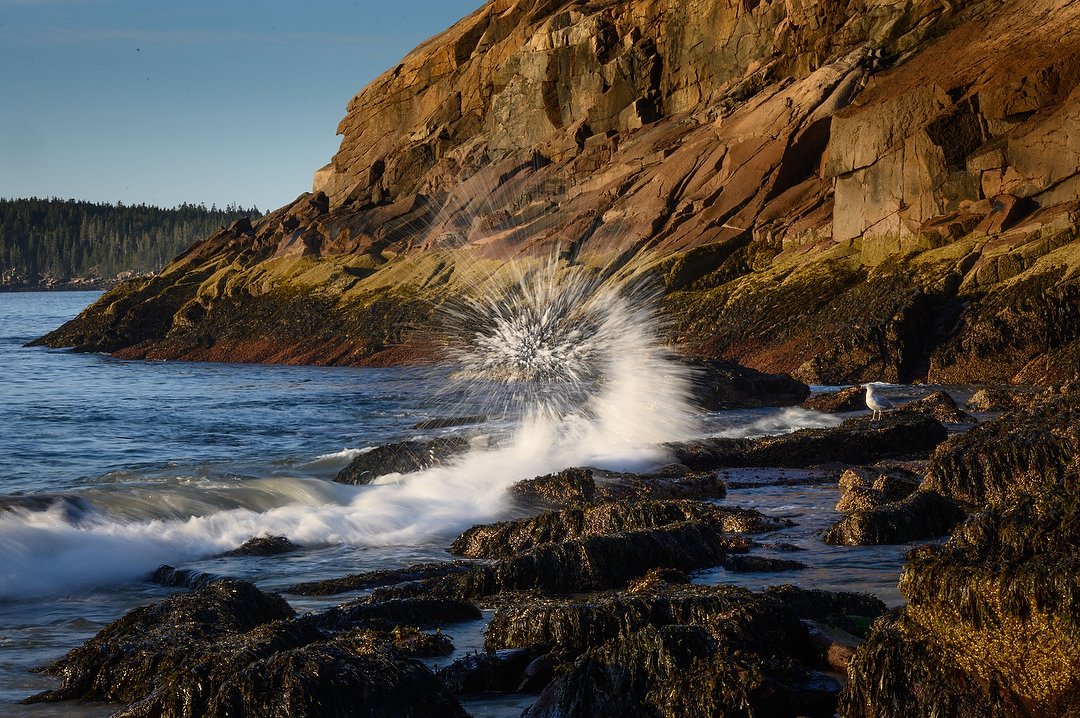
Mostly we do traditional long exposure photos of the waves and rocks at Sand Beach, but when I saw this lone seagull perched there, I decided to use it in my photo. Nikon Z 6 II, Aperture Priority, Natural auto white balance, ISO 50, 1/10 at f/32 in Matrix metering, -1.3 EV, Nikkor Z 24-200mm f/4-6.3 VR lens at 97mm.
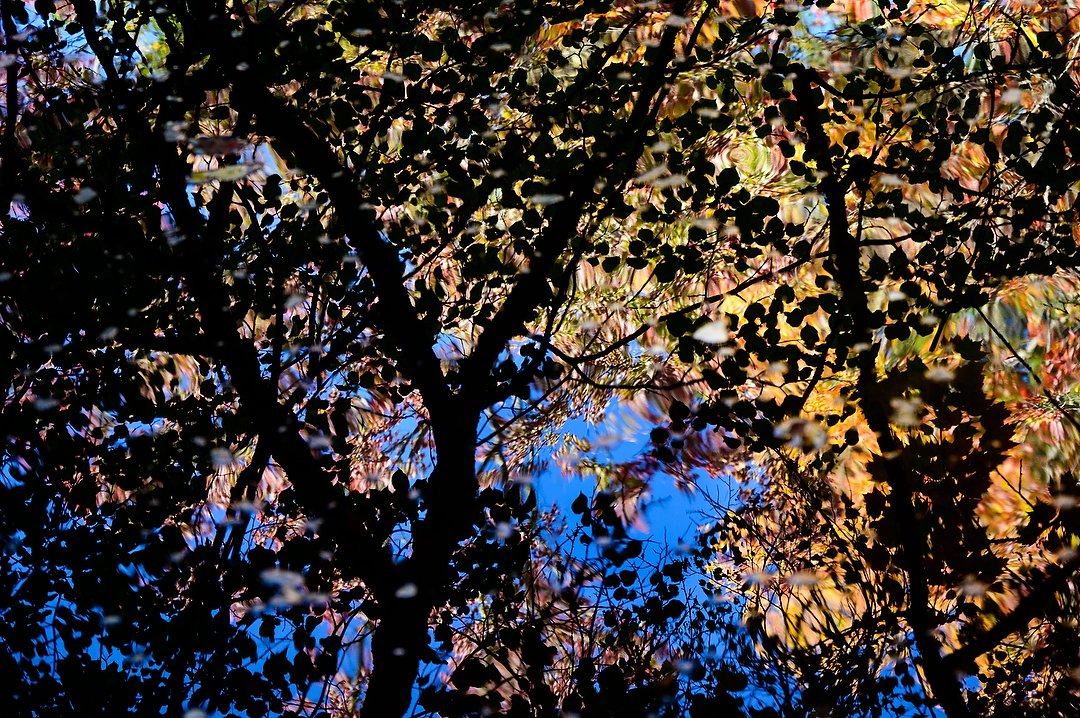
This pond near the cemetery in Somesville offered some nice fall reflections, and I photographed them through a tree in the shade. Nikon Z 6 II, Aperture Priority, Natural auto white balance, ISO 400, 1/60 at f/7.1 in Matrix metering, -1.3 EV, Nikkor Z 24-200mm f/4-6.3 VR lens at 100mm.
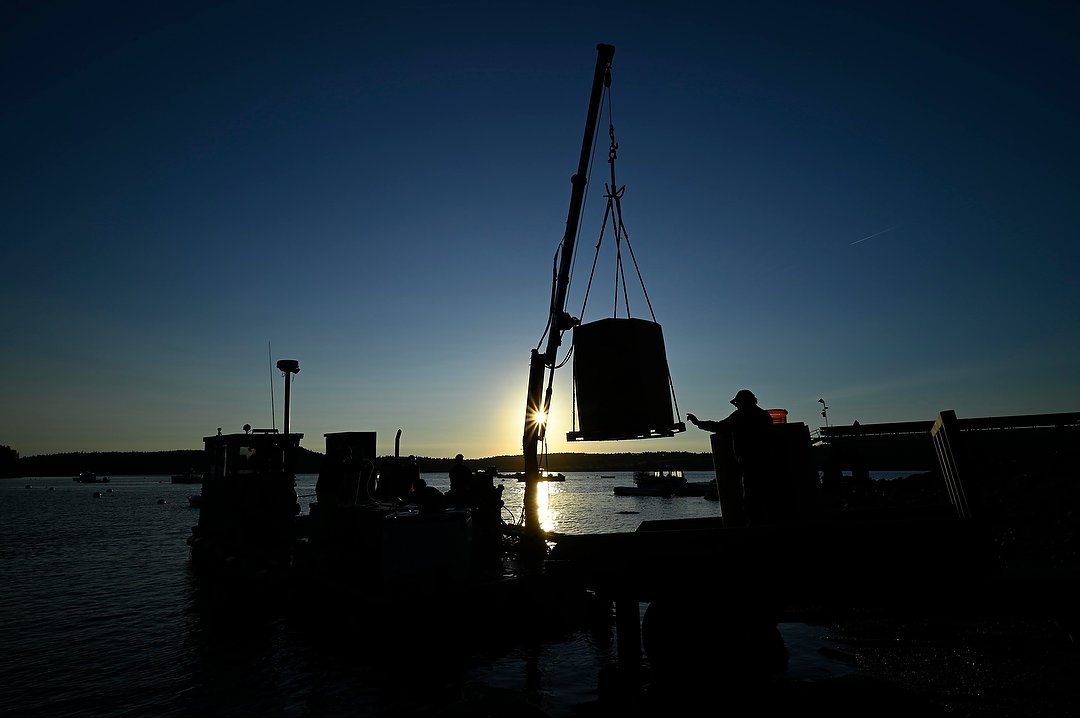
We chose a small bay on the western side of the island for our final sunset shoot, and while there learned about the mussel business as a boat unloaded its catch. By positioning myself where the crane partially blocked the sun, and using a small aperture, I was able to create a “sunburst.” Nikon Z 6, Aperture Priority, Sunny white balance, ISO 125, 1/320 at f/16 in Matrix metering, -1.3 EV, Nikkor Z 14-30mm f/4 S lens at 18mm.
The workshop concluded that evening with pizza at my assistant’s home in the woods outside Bar Harbor. We’d had a great week together, with some fall color, a pair of gorgeous sunrises and many, many excellent photo opportunities in this jewel of the east coast. I look forward to doing it again in the fall of 2022!
(If you like this story, please share it with your friends and let them know about the links on photography that I post on my business Facebook page. I’m also on Instagram and Twitter, @reedhoffmann. And if you’re curious about the workshops I teach (and I’ll return to Acadia in the fall of 2022), you can find them here. And, you can subscribe to this blog on my home page.)

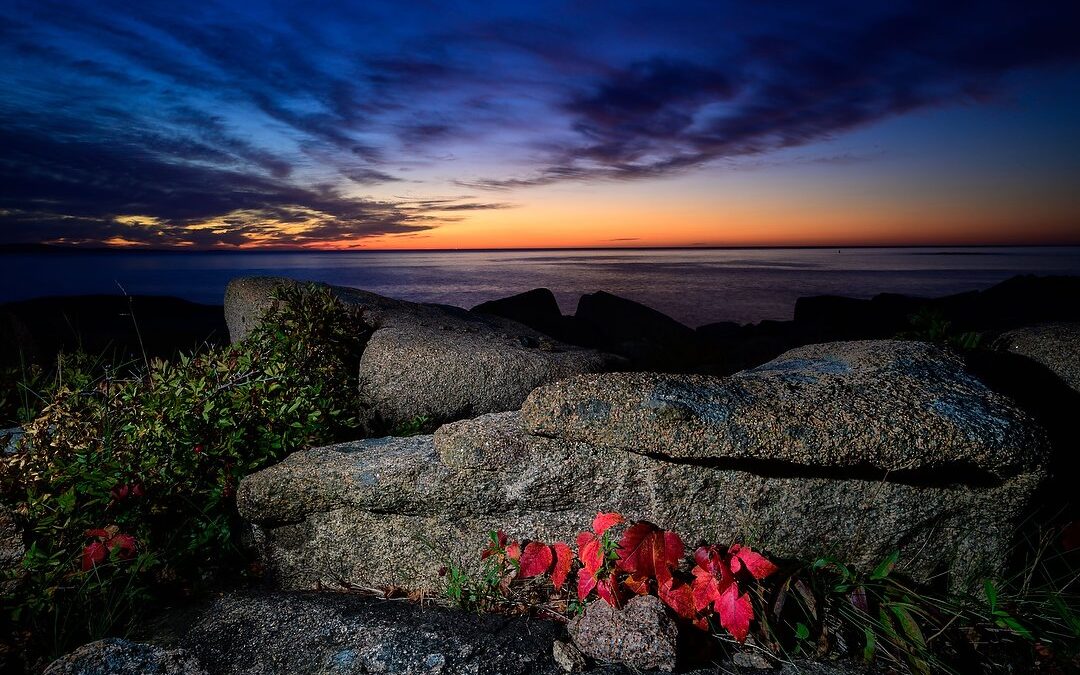
Reed, Thanks for including me on 3 trips (Moab, Acadia & Sedona). The scenery and photo opportunities have been great but the other people on the trips have always been interesting and fun to be with. Looking forward to another trip with you someday soon.
Always great to have you along, Lynn, and I agree, it’s the people that help make a trip special. I’m always grateful to have such a wonderful group of folks who enjoy doing the trips with me.
I was there with one of your groups years ago, Reed….but if I live to be 100, my photos will never ever ever compare with your amazing work!!!!
Aw, thanks Ilene!
Thanks Reed. Great stories, terrific images and wonderful memories of the trip!